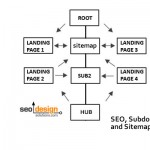What is link flow distribution in a website and why should you care? Link flow is a metric implemented in SEO which assesses the volume of link equity (accumulated PageRank, citation factor and nodes of relevance) a page has and how it passes along that equity via outbound links to other internal or external pages.
Depending on the degree of inbound links from other pages within your website or from other web pages online provide characteristics that distinguish that page in search engines.
For example, a page can rank in search engines as a result of:
- Aggregate On page Factors
- Consolidated internal links
- Off page inbound links (with specific anchor text)
- Domain authority and some degree of on page correlation
For the sake of analogy, link flow is like the circulatory system for a website, if it is crimped, a page suffers from link attrition, if the arteries (links) to a page are plentiful; the page flourishes as a result of being nurtured from subordinate pages and takes on the role of a preferred landing page.
Essentially, there are two types of pages in a website (1) the pages that are intended to rank well and garner conversion from consumers and (2) supporting pages housing informative, relevant content created for the purpose of (a) increasing the semantic footprint of a website to increase topical relevance and (b) link to preferred landing pages.
This alone when coupled with another prominent element known as domain authority can catapult newly dubbed preferred landing pages into the spotlight in search engines. The source of the link becomes less important as the degree of trust and domain authority increase for the source of the page providing the link.
For example, amazon.com is one of the most authoritative domains online, hence an internal link to a page is often more powerful than an entire website competing against it. Internal pages within Amazon can rank from a few inbound links, whereas a competitor may require thousands of links to equate to the degree of link flow passes along from the internal links within Amazon alone.
This is why you cannot always count links and assume that volume is the only metric which applies weight within ranking algorithms. They must be assessed based on internal link flow, page authority, domain strength, trust and how old the page is and whether or not it is grandfathered (algorithmically) into the top 10 results.
Also, additional considerations are the number of outbound links on the page providing the link and the number of outbound links on the preferred landing page dramatically impact buoyancy in search engines.
This is considered a component of link-loss or rather hemorrhaging link-flow (like a bucket with 100 large holes in it). Under this analogy, it doesn’t matter how much water you put in the bucket, it all ends up spilling out (ineffectually)
For example, we apply a tiered system to websites and categorize important (pivotal) keywords that are part of the parent theme (semantic cluster) that define the purpose or (primary focus) of a website.
By elevating these primary themes into the navigation, breadcrumbs, footer links, secondary navigation from specific pages in the sidebar or server side includes – this way, you can sculpt the link flow distribution within the website to correspond to your primary ranking objectives.
In addition to creating prominent regions of relevance through implementing site architecture or design changes, simplifying elements such as minimizing outbound links per page and consolidating link flow on themed (similar) pages can also reinforce a stable search engine position (without having to resort to off page tactics to produce rankings).











Another great post. I’m not sure what your name is but I think you have one of the more advanced SEO blogs on the internet and your WordPress plug in absolutely rocks. This is quickly becoming my favorite resource. Keep it coming, I want to know all your secrets:)
Thanks Andres:
And for my next trick, I will change all SEO Secrets and information exchanged on the blog to a pay per post value, monetize the plugin and charge for techniques by the minute… muah, muah, muah “hands rubbing” sardonically.
Just kidding, Thanks and we appreciate the kudos on SEO Ultimate and the content.
All the best!
On the surface SEO appears to be “kinda” simple but to the average Joe like me, it’s kinda overwhelming. I want to know your secrets too!
tnx for posts